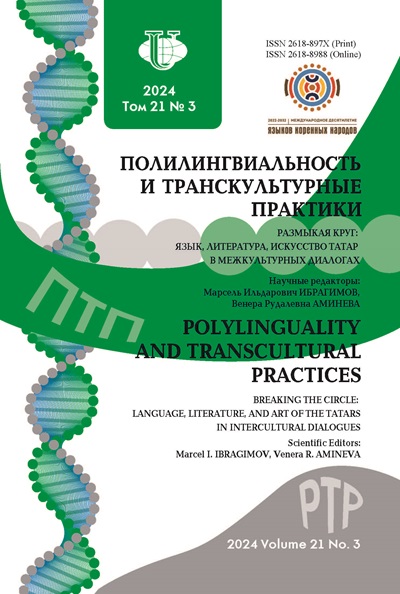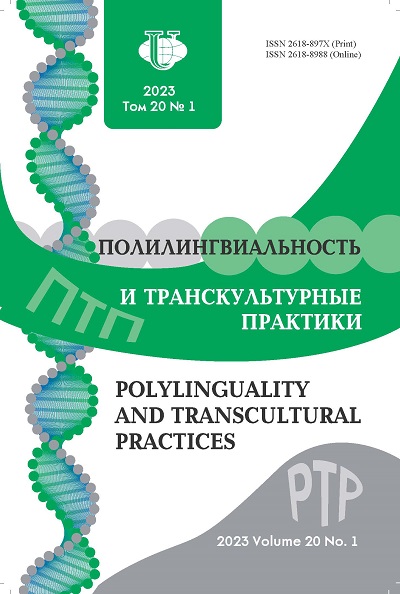Letters, Memory, Language: about Russian Transcultural Literature
- Authors: Shafranskaya E.F.1
-
Affiliations:
- Moscow City Pedagogical University
- Issue: Vol 20, No 1 (2023)
- Pages: 55-65
- Section: LITERARY SPACE
- URL: https://journals.rudn.ru/polylinguality/article/view/34391
- DOI: https://doi.org/10.22363/2618-897X-2023-20-1-55-65
- EDN: https://elibrary.ru/WNOMWS
Cite item
Full Text
Abstract
The author of the article focuses on the image of letters as a symbol of national historical memory — on the example of Sukhbat Aflatuni’s story “Clay letters, floating apples”, where the letters act not only in their direct meaning, they are the antithesis of the imposed culture, language, historical interpretations. The article substantiates the legitimacy of using the term “transcultural literature” instead of the common and illogical one — “Russian-language literature”, since in this type of creativity the image of a different ethnic picture of the world, other national images of the world is paramount. The novel “Hands-rivers” by the contemporary writer Liana Shahverdyan is analyzed precisely in the categories of transcultural literature: the novel highlights the key themes and problems associated with the restoration of ancestral memory of family and the Armenian people, who, like millions of Soviet citizens, were subjected to Stalinist repressions. The metaphor of the carpet weaving culture, the carpet, the images of the local fauna — birds and snakes became the key ones in the analysis of the plot of the novel “Hands-rivers”. The novel by Liana Shahverdyan, based on archival documents, fills in the lost page of the history of the ХХth century, thus fitting into the current archival vector of the contemporary literary process.
About the authors
Eleonora F. Shafranskaya
Moscow City Pedagogical University
Author for correspondence.
Email: shafranskayaef@mail.ru
ORCID iD: 0000-0002-4462-5710
SPIN-code: 5340-6268
of Philology, Associate Professor, Professor of the Russian Literature Department
4, building 1, 2nd Agricultural passage, Moscow, 129226, Russian FederationReferences
- Shafranskaya, E.F., Garipova G.T., Smirnova A.I. 2022. “Metafory ostanovivshegosya vremeni v sovremennoj literature”. Filologicheskie nauki. Nauchnye doklady vysshej shkoly 4: 132–142. Print. (In Russ.).
- Bahtikireeva, U.M. 2015. “Russkoyazychie kak aktual’naya mezhdisciplinarnaya problema”. Social’nye i gumanitarnye nauki na Dal’nem Vostoke 1(45): 92–97. Print. (In Russ.).
- Bahtikireeva, U.M., Valikova O.A. 2017. “Istoki translingval’noj russkoyazychnoj literatury”. Social’nye i gumanitarnye nauki na Dal’nem Vostoke XIV(1): 14–19. Print. (In Russ.).
- Bahtikireeva, U.M. 2021. “Rusofon — rusofonnyj — rusofoniya — rusofonnaya literatura — slova global’nye ili lokal’nye?”. Social’nye i gumanitarnye nauki na Dal’nem Vostoke XVIII (1): 11–17. Print. (In Russ.).
- Garipova, G.T. 2020. “ ‘Arheologiya pis’ma’ ili slozhnoorganizovannyj smysl metasoznaniya H. Ismajlova”. Voprosy filologii 3: 77–84. Print. (In Russ.).
- Garipova, G.T. 2021. “Principy miromodelirovaniya v russkoj proze XX veka (neklassicheskaya paradigma hudozhestvennosti)”: Doctoral Thesis. Vladimir. Print. (In Russ.).
- Garipova, G.T. 2020. “Polilingvizm i transliteraturnost’ v kontekste metafikciol’nyh strategij Hamida Ismajlova”. Polilingvial’nost’ i transkul’turnye praktiki 17(1): 78–87. Print. (In Russ.).
- Garipova, G.T. 2018. “Kalendar’ Moskvy: ‘Sobranie utonchennyh’ i prostranstvo Londona v metasoznanii Hamida Ismajlova”. In Genius loci v literature, iskusstve, kul’ture. SPb.: Svoe izd-vo. Pp. 71–86. Print. (In Russ.).
- Abdullaev, E.V. 2021. Kak ubit’ literaturu: ocherki o literaturnoj politike i literature nachala XXI veka. Moscow: Eksmo. Print. (In Russ.).
- Shafranskaya E.F. Arhivnyj vektor v sovremennoj russkoj literature // Przegląd Rusycystyczny. Pol’sha, 2022. № 4(180). S. 25–38.
- Shafranskaya, E.F. 2021. “Butovskij poligon vs Nukusskij muzej imeni I.V. Savickogo”. Znamya 7: 180–205. Print. (In Russ.).
- Kannadan, Sh.M. 2013. “Istoriya ornamental’nyh tradicij v kovrotkachestve Irana i Central’noj Azii”: Candidate Thesis. Dushanbe. Print. (In Russ.).
- Kanaeva, N. 2013. “Kover mozhno chitat’ kak knigu”. Golos Armenii. Web. URL: https:// www.golosarmenii.am/article/17371/kover-mozhno-chitat--kak-knigu (data obrashcheniya: 01.11.2022).
- Kazanova, P. 2003. Mirovaya respublika literatury. Moscow: Izd-vo im. Sabashnikovyh. Print. (In Russ.).
- Garipova, G.T. 2021. “Specifika sociokul’turnoj modeli uzbekskoj literatury v postsovetskuyu epohu”. In Problemy raspada i naslediya SSSR v sovremennom publichnom prostranstve Proceedings, Moscow, April, 19, 2021. Moscow: Knigodel. Pp. 105–116. Print. (In Russ.).
- Harchenko, A. 2006. Hristianskij monastyr’ v Urgute. Fergana. Ru. Web. URL: https://samtur. uz/na/155-otkuda-v-urgute-hristianskij-monastyr.html?fbclid=IwAR3pVhQGmj3tKGYMD d0L9NC7FfBrV2IP2Bzd5YUr-kVM-MQ5ERFx7tjSmYI&_utl_t=tm (data obrashcheniya: 01.11.2022).















